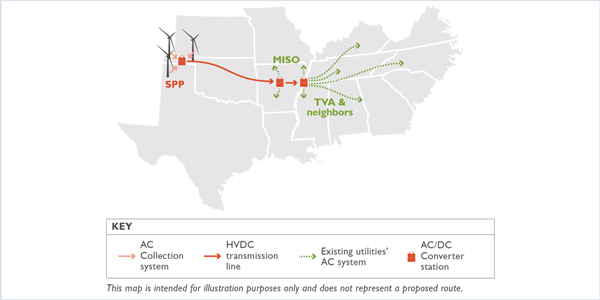By Tom Kleckner
Clean Line Energy Partners said Thursday that market realities led the company to sell its Oklahoma assets to NextEra Energy and put a temporary halt on its Plains & Eastern Clean Line project.
In the meantime, Clean Line founder and president Mike Skelly told RTO Insider, the company will focus on its four other long-haul HVDC projects.
“We’re adapting to the headwinds,” Skelly said. “You have to adapt.”
Clean Line announced in December that NextEra had purchased the assets of the Oklahoma portion of its $2.5 billion Plains & Eastern project, which was to deliver 3.5 GW of wind energy to Memphis, Tenn., and the Tennessee Valley Authority. (See Clean Line Sells Okla. Portion of Plains & Eastern to NextEra.)
The deal was sealed after it became apparent to Clean Line that TVA had little appetite to complete a six-year-old memorandum of understanding to purchase the project’s wind power. Late last year, just weeks after TVA said it was still studying whether to sign the contract, agency President Bill Johnson said the Clean Line project didn’t make economic sense, given TVA’s flat demand and ample generating capacity.
“We fund these projects with investor dollars, not ratepayer dollars,” Skelly said. “We were sort of hoping TVA would anchor this line by buying energy.”
Skelly said Clean Line began considering its options when it was approached by renewable energy powerhouse NextEra regarding its Oklahoma assets. The purchase includes Clean Line’s Oklahoma right of way.
“While getting that piece of the line built wasn’t everything we wanted to get done, it’s a significant thing,” Skelly said. “Now, the biggest renewables provider in the country owns this [400] miles of right of way. We believe that will enable them, or them working with others, to build a few gigawatts of wind. Our goal has always been to get more gigawatts on the grid, and that’s a positive outcome.”
Clean Line had intervened in Public Service Company of Oklahoma’s (PSO) $4.5 billion Wind Catcher project, which is currently before the Oklahoma Corporation Commission (Docket 17-267). Clean Line Executive Vice President Mario Hurtado called the Wind Catcher proposal “a good idea” in written testimony and suggested that PSO could take advantage of the easements his company has already secured.
“Schedule delays could jeopardize the size of the benefit to ratepayers from the production tax credit,” Hurtado said. “The Plains & Eastern project could substantially mitigate the cost and schedule risks for Wind Catcher.”
NextEra did not respond to a request for comment on its plans.
Clean Line has not entirely given up on Plains & Eastern, which has approval from the Tennessee Regulatory Authority and a “record of decision” from the U.S. Department of Energy to participate in its development under Section 1222 of the 2005 Energy Policy Act. (See DOE Agrees to Join Clean Line’s Plains & Eastern Project.)
Clean Line has held on to the project’s Arkansas right of way, although the company has encountered heavy opposition from lawmakers and landowners in the state. However, in the waning days of 2017, it also received a favorable ruling from a federal judge in a lawsuit that confirmed DOE’s participation in the project.
“We’ve been working on this thing for eight years,” Skelly said. “We’ve been working with and trying to convince the TVA and other Southeastern utilities of the merits of low-cost renewable energy. It’s been a long, slow process.”
Asked whether the decision to sell its Oklahoma assets was driven by a combination of TVA’s reluctance and the need for funding, Skelly said, “That’s not an unfair conclusion.”
“It’s more the market than the financing,” he said. “Our read of the market is that … it doesn’t appear [the Southeastern utilities] are going to do large renewable purchases in the short term. We would argue their customers want it, it’s cost effective, it’s technically feasible … we think there’s demand, but they don’t want to [meet it], and that’s their choice.”
Clean Line will now turn its attention to the proposed 780-mile Grain Belt Express, a $2.3 billion initiative that would deliver 4 GW of wind power from western Kansas through Missouri and Illinois to the Indiana border. The project is working its way through the appellate court process in Missouri, aided by former Gov. Jay Nixon. (See Unfazed by Obstacles, Clean Line’s Skelly Focuses on Future.)
“It’s been a somewhat protracted legal process, but we anticipate that will be sorted out second quarterish,” Skelly said.
Clean Line’s other three projects include:
- The Rock Island Clean Line, a 500-mile project from northwest Iowa to Illinois, delivering 3.5 GW of wind energy. The project was originally expected to be operational in 2017. But on Sept. 21, the Illinois Supreme Court rejected the Rock Island application because Clean Line held only an option agreement on a parcel for a converter station — rather than a completed purchase agreement — when it applied to the Illinois Commerce Commission. The company said the ruling will cause “great delay” for the project.
- The Centennial West Clean Line, a 900-mile project delivering 3.5 GW of renewable energy from New Mexico and Arizona to California. The company had expected construction to begin in 2017 and be operational in 2019. Development has slowed down while the company works on its other projects.
- The Western Spirit Clean Line, a 140-mile project complementing the Centennial West project, delivering 1 GW of renewable power from east-central New Mexico to markets in the western U.S. Clean Line acquired the project, originally named Power Network New Mexico, in 2013. Construction, which will take about one year, could begin by the end of 2018.






